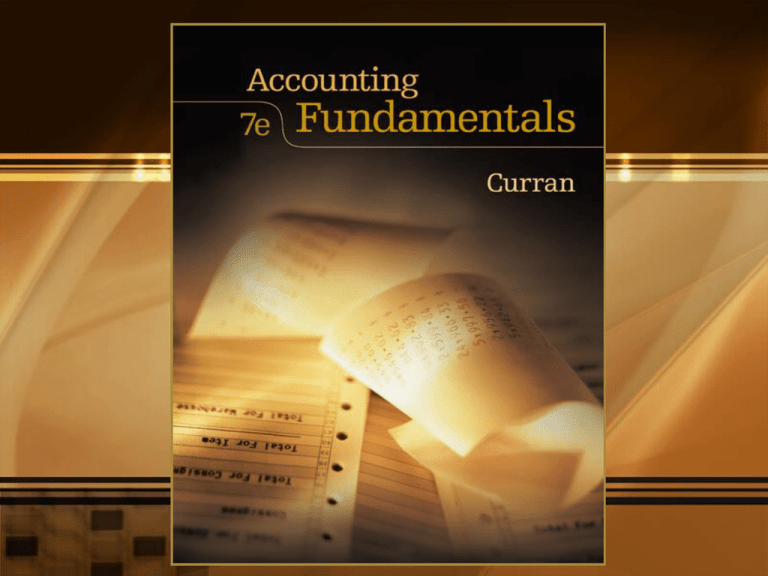
CHAPTER FOUR
REVENUE AND
EXPENSE
ACCOUNTS
4-3
REVENUE AND EXPENSE
ACCOUNTS
Objectives:
1. Record debits and credits in revenue,
expense, and withdrawal accounts.
2. Explain the rules of debit and credit.
3. Apply the rules of debit and credit for
revenue, expense, and withdrawals on
owner’s equity.
McGraw-Hill/Irwin
Accounting Fundamentals, 7/e
© 2006 The McGraw-Hill Companies, Inc., All Rights Reserved.
4-4
Recording Revenue
•The increase in the owner’s
equity that results from revenue
is recorded in a separate
revenue account.
McGraw-Hill/Irwin
Accounting Fundamentals, 7/e
© 2006 The McGraw-Hill Companies, Inc., All Rights Reserved.
4-5
Recording Expenses
•Separate expense accounts
should be used to record costs
of doing business.
McGraw-Hill/Irwin
Accounting Fundamentals, 7/e
© 2006 The McGraw-Hill Companies, Inc., All Rights Reserved.
4-6
Recording the Owner’s
Withdrawals
•The owner of a business may use
cash or other assets personally.
This is recorded in the withdrawal
account.
McGraw-Hill/Irwin
Accounting Fundamentals, 7/e
© 2006 The McGraw-Hill Companies, Inc., All Rights Reserved.
4-7
The Rules of Debit and Credit
Assets
•Balance side is debit side
•Increase side is debit side
•Decrease side is credit side
McGraw-Hill/Irwin
Accounting Fundamentals, 7/e
© 2006 The McGraw-Hill Companies, Inc., All Rights Reserved.
4-8
The Rules of Debit and Credit
(continued)
Liabilities
•Balance side is credit side
•Increase side is credit side
•Decrease side is debit side
McGraw-Hill/Irwin
Accounting Fundamentals, 7/e
© 2006 The McGraw-Hill Companies, Inc., All Rights Reserved.
4-9
The Rules of Debit and Credit
(continued)
Owner’s Equity
• Beginning investment is on
credit side
• Increases are on credit side
• Decrease are on debit side
McGraw-Hill/Irwin
Accounting Fundamentals, 7/e
© 2006 The McGraw-Hill Companies, Inc., All Rights Reserved.
4-10
The Rules of Debit and Credit
(continued)
Revenue Accounts
•Increases in owner’s equity
through revenue are on the credit
side
•Decreases in owner’s equity
through reduction of revenue are
on the debit side
McGraw-Hill/Irwin
Accounting Fundamentals, 7/e
© 2006 The McGraw-Hill Companies, Inc., All Rights Reserved.
4-11
The Rules of Debit and Credit
(continued)
Expense Accounts
• Decreases in owner’s equity
through expenses on the debit
side
• Increases in owner’s equity
through reduction of expense on
the credit side
McGraw-Hill/Irwin
Accounting Fundamentals, 7/e
© 2006 The McGraw-Hill Companies, Inc., All Rights Reserved.
4-12
Transaction
•Rebecca Van Lieu tested and
screened job applicants for $800 on
credit for a client, Donald Lynch.
McGraw-Hill/Irwin
Accounting Fundamentals, 7/e
© 2006 The McGraw-Hill Companies, Inc., All Rights Reserved.
4-13
Transaction Analysis
•The increase in the asset Accounts
Receivable is recorded as a debit to
the Accounts Receivable account.
•Because revenue was earned,
owner’s equity increased and is
reflected by a credit to revenue.
Account
Accounts Receivable
Revenue
McGraw-Hill/Irwin
Accounting Fundamentals, 7/e
Debit
800
Credit
800
© 2006 The McGraw-Hill Companies, Inc., All Rights Reserved.
4-14
Transaction
•Rebecca Van Lieu received $400 on
account from Donald Lynch.
McGraw-Hill/Irwin
Accounting Fundamentals, 7/e
© 2006 The McGraw-Hill Companies, Inc., All Rights Reserved.
4-15
Transaction Analysis
• This transaction involves only an
exchange of one asset (accounts
receivable) for another (cash).
• It is recorded by debiting the Cash
account and crediting the Accounts
Receivable account.
McGraw-Hill/Irwin
Accounting Fundamentals, 7/e
© 2006 The McGraw-Hill Companies, Inc., All Rights Reserved.
4-16
Transaction Analysis (continued)
Account
Cash
Accounts Receivable
McGraw-Hill/Irwin
Accounting Fundamentals, 7/e
Debit
400
Credit
400
© 2006 The McGraw-Hill Companies, Inc., All Rights Reserved.
4-17
Transaction
•Rebecca Van Lieu withdrew $500 in
cash from her business for her
personal use.
McGraw-Hill/Irwin
Accounting Fundamentals, 7/e
© 2006 The McGraw-Hill Companies, Inc., All Rights Reserved.
4-18
Transaction Analysis
• Owner’s equity is decreased by
$500 by debiting the Withdrawals
account.
• The asset Cash is decreased by
$500 by crediting the Cash account
Account
Debit
Rebecca Van Lieu, Withdraw als
Cash
McGraw-Hill/Irwin
Accounting Fundamentals, 7/e
Credit
500
500
© 2006 The McGraw-Hill Companies, Inc., All Rights Reserved.
4-19
Accounting Terminology
•Owner’s equity accounts
•Withdrawals
McGraw-Hill/Irwin
Accounting Fundamentals, 7/e
© 2006 The McGraw-Hill Companies, Inc., All Rights Reserved.
4-20
Chapter Summary
• Many business transactions involve earning
revenue and incurring expenses.
• A separate account is opened for each
major revenue and expense.
• A separate withdrawal account is opened to
record the owner’s withdrawals.
McGraw-Hill/Irwin
Accounting Fundamentals, 7/e
© 2006 The McGraw-Hill Companies, Inc., All Rights Reserved.
4-21
Chapter Summary (continued)
•At the end of the period of operations,
all revenue and expenses are totaled.
•Net income or loss is derived after
subtracting expenses from revenue
and increases or decreases the
owner’s equity.
McGraw-Hill/Irwin
Accounting Fundamentals, 7/e
© 2006 The McGraw-Hill Companies, Inc., All Rights Reserved.
4-22
Chapter Summary (continued)
•Withdrawals are subtracted from the
net income to show the net increase
or decrease in the owner’s equity.
McGraw-Hill/Irwin
Accounting Fundamentals, 7/e
© 2006 The McGraw-Hill Companies, Inc., All Rights Reserved.
4-23
Topic Quiz
Answer the following true/false questions:
1. The balance side of a revenue account
is the debit side.
FALSE
2. The balance side of an expense account
is the debit side.
TRUE
3. If withdrawals exceed net income,
the owner’s equity is increased.
FALSE
McGraw-Hill/Irwin
Accounting Fundamentals, 7/e
© 2006 The McGraw-Hill Companies, Inc., All Rights Reserved.
4-24
Investigating on the Internet
Sources of information about revenue
and expense accounts can be accessed at a
website for a business.
As a research assignment, access the
corporate website and report those
sources of information that might
concern revenue and expense accounts
used in the operation of the business.
McGraw-Hill/Irwin
Accounting Fundamentals, 7/e
© 2006 The McGraw-Hill Companies, Inc., All Rights Reserved.
4-25
1. The balance side of a revenue account is the
debit side.
FALSE
The balance side of a revenue
account is the credit side.
McGraw-Hill/Irwin
Accounting Fundamentals, 7/e
(Return to Topic Quiz)
© 2006 The McGraw-Hill Companies, Inc., All Rights Reserved.
4-26
3. If withdrawals exceed net income,
the owner’s equity is increased.
FALSE
The owner’s equity is
decreased.
McGraw-Hill/Irwin
Accounting Fundamentals, 7/e
(Return to Topic Quiz)
© 2006 The McGraw-Hill Companies, Inc., All Rights Reserved.









